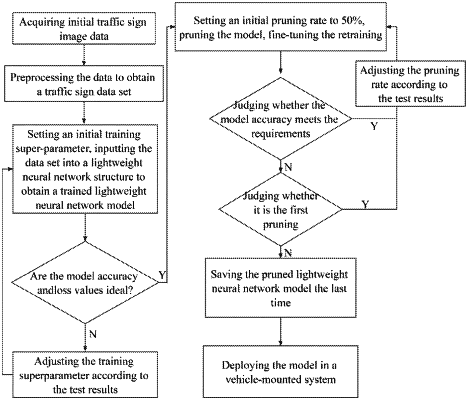| CPC G06V 20/582 (2022.01) [G06V 10/26 (2022.01); G06V 10/32 (2022.01); G06V 10/764 (2022.01); G06V 10/774 (2022.01); G06V 10/776 (2022.01); G06V 10/7715 (2022.01); G06V 10/82 (2022.01)] | 6 Claims |

|
1. A traffic sign recognition method based on a lightweight neural network, comprising following steps:
step 1, acquiring initial traffic sign image data;
step 2, data preprocessing: preprocessing the initial traffic sign image data to obtain a traffic sign data set with a training set and a test set;
step 3, setting an initial training super-parameter, inputting a training set part of the traffic sign data set into a lightweight neural network model for a training, and recognizing a trained lightweight neural network model by using a test set part of the traffic sign data set; the lightweight neural network model comprises a convolution feature extraction part and a classifier part; the convolution feature extraction part comprises a layer of conventional 3×3 convolution and 16 layers of separable asymmetric convolution; the separable asymmetric convolution comprises a first separable asymmetric convolution and a second separable asymmetric convolution; the first separable asymmetric convolution firstly carries out feature separation on each input channel; secondly, a 1×3 convolution and a 3×1 convolution with a step length of 1 and a padding of 0 are respectively performed on each channel; after the convolution, obtaining two single-channel feature maps with same sizes by a nonlinear Relu, rectified linear unit, activation function; then summing corresponding elements of the two single-channel feature maps respectively, and performing a batch normalization on each channel summed and by an Relu activation function in turn; then merging and shuffling each newly formed channel; finally, performing a 1×1 convolution with a step length of 1 on output channels, and setting a number of convolution kernels equal to a number of input channels;
the second separable asymmetric convolution firstly carries out feature separation on the each input channel; secondly, a 1×3 convolution and a 3×1 convolution with a step length of 1 and a padding of 0 are respectively performed on each channel; after the convolution, obtaining two single-channel feature maps with same sizes by a nonlinear Relu activation function; then summing corresponding elements of the two single-channel feature maps respectively, and performing a batch normalization on each channel summed and by an Relu activation function in turn; then merging and shuffling each newly formed channel; finally, performing a 1×1 convolution with a step length of 2 on output channels to complete a downsampling of the feature maps, and setting a number of the convolution kernels equal to a number of input channels; wherein the classifier part comprises three layers of separable full connection modules;
step 4, checking whether a recognition accuracy of the model on the test set reaches more than 90%, if not meet requirements, adjusting the training super-parameter and going to the step 3; otherwise, going to step 5;
step 5, pruning the lightweight neural network model, setting an initial pruning rate to 50%, then performing a retraining on a pruned lightweight neural network model on the training set of the traffic sign data set, and recognizing a trained pruned lightweight neural network model on the test set of the traffic sign data set;
step 6, checking the recognition accuracy of the trained pruned lightweight neural network model; if a loss of the recognition accuracy is less than 1%, saving the model and continuing to increase the pruning rate with a step length of 2%, and turning to the step 5, if the loss of the recognition accuracy exceeds 1%, judging whether it is a first pruning result; if it is the first pruning result, reducing the pruning rate with a step length of 10% and returning to the step 5; if it is not the first pruning result, going to step 7;
step 7, saving the pruned lightweight neural network model last time; and
step 8, deploying the pruned lightweight neural network model last time in a vehicle-mounted system to recognize traffic signs on a road.
|